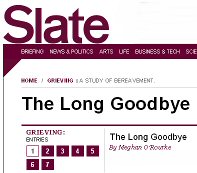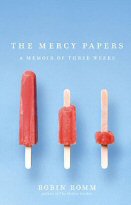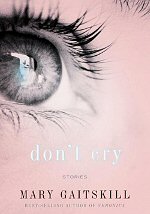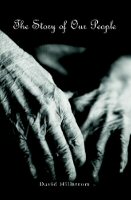 Meghan O’Rourke’s Slate series of reflections on the loss of her mother provides, in a complementary way, some other ways to look at death and grieving. Romm’s memoir was fresh in my mind when I read the seven parts to O’Rourke’s pieces from start to finish. After all, there must be other interpretations, other aspects to adjustment, to acceptance — both by the dying and by their survivors.
Meghan O’Rourke’s Slate series of reflections on the loss of her mother provides, in a complementary way, some other ways to look at death and grieving. Romm’s memoir was fresh in my mind when I read the seven parts to O’Rourke’s pieces from start to finish. After all, there must be other interpretations, other aspects to adjustment, to acceptance — both by the dying and by their survivors.
But I was not persuaded (and O’Rourke is not after any mind-changing; the grief-striken are in a far different place) of the potential for anything short of the angry, wounding ricochets of loss Romm documented.
(c) 2009 by Mark Underwood
Readings
Share book reviews and ratings with DV,
and even join a book club on Goodreads.
The Unceasing Wail (And Barb Would Like Her CD Back)
 In the echo chamber of pain and tears Robin Romm inhabits in The Mercy Papers (Scribner, 2009), there are other characters: father Richard, boyfriend Don and a mother, Jackie, “who was the first to notice when the crocuses bloomed each spring,” even after she had been diagnosed with metastatic breast cancer. And other characters, too. But Ms. Romm’s shrieks are so piercing, so monstrously realistic that nearly all other voices are drowned out in this narrative.
In the echo chamber of pain and tears Robin Romm inhabits in The Mercy Papers (Scribner, 2009), there are other characters: father Richard, boyfriend Don and a mother, Jackie, “who was the first to notice when the crocuses bloomed each spring,” even after she had been diagnosed with metastatic breast cancer. And other characters, too. But Ms. Romm’s shrieks are so piercing, so monstrously realistic that nearly all other voices are drowned out in this narrative.
This is as it should be.
Readers should be prepared for plainly difficult passages such as:
On very bad days, Mom will look up at me, fear and pain staining the brown in her eyes, and she will say, ” I want to go home.”
“You are home, Mom,” I say, holding her hand, which is hard as plastic from edema.
“I know, ” she says, her face pleading, “but I want to go home.” My dad says I’m attaching meaning to this when it’s nonsense.
At other times, The Mercy Papers’ rant achieves more. This is where Romm is at her best, craft giving lift to the despair where nothing else could. That lift — one is reluctant to use a more demonstrative expression — is very much in need.
Legacy.com operates a hosted for paid obituary notices for 275 national newspapers, including the New York Times (not to mention Gadzoo, a pet finder service, perhaps suited to the sensibilities of the Company) . As fate would have it, I’ve had occasion to sponsor a legacy.com post / guest book and to visit three others since January. A casual visit to most guest books on legacy.com confirms Romm’s perception that outside the small world of those directly affected by the loss, an abundance of platitudes and poorly reasoned sentimentalities serves to create a sense of isolation. In Papers, this plays out in many scenes. One that comes to mind comes after Jackie asks the rabbi what happens in Judaism after people die and the rabbi offers up that “there is a great energy in the universe . . . and when you die you rejoin this great energy.” Little wonder the sense of estrangement deepens as this memoir continues:
We could get a cup of coffee. But who wants coffee? Who wants to see anyone in the outside world? The outside world has gotten increasingly foreign. People smile for no reason, purchase sugary snacks, worry over leaky roofs out loud to strangers. Who needs this? No one in this house wants to talk about leaky roofs. We want to sit quietly and be known. We want to be soothed by quiet warm hands. We want to be passive, have the world come to us. If we are going to use our tiny reserve of energy to strike up conversation with a stranger, well, it might as well be with God. No one else is useful. Not that God is being very useful — up there punching buttons on his death remote, smirking away.
Or, as Romm writes elsewhere, having nine years to prepare for the coming death still left her ill-prepared, and she works to convince the reader that this is as it should be.
. . . the changes won’t be hopeful — like the clarity of vision I sometimes feel when I’m in my bedroom after crying and the lines of the windows and slatted doors all look too sharp, hyper-sharp, and all people seem tragic and plain to me, easy to understand. Some of the changes will be only pain. Pain when I see babies, pain when my friends go to lunch with their mothers, pain on my birthday, on her birthday, on every birthday of every person I know. Pain and a deep, toothy hollowness inside me that will go on grinding forever.
There’s some transference/substitution wound in the author’s psyche, as there’s far too much narration about pets. Even though the comings and goings, food ingestion and waste discharging of the beasts lends a certain authenticity to the story, this may appeal to only to inveterate animal lovers. On the other hand, had Ms. Romm not been an only child, descriptions of siblings might have been no less meaningless.
When the reader arrives tearful and bloodied (and the blood will not all be your own) on page 194, Ms. Romm gifts the purchaser of this volume twelve Six Feet Under-esque blank journal pages (imagine the conversations with the publishing house over this decision).
Loss doesn’t end. It goes on and on and on, written on every day that will follow.
There you have it. Twelve blank pages for notes, after 194 pages of meticulous coaching. Preparatory notes, should it not yet be your time for such loss. Or, if your time has come, as it has for me and my mother (www.billieunderwood.com) only three months ago, then twelve blank pages just to gather up the bits of memory that loss has tried its best to obliterate. Ultimately, there is no making sense of it, but we are each judged — perhaps by someone much like Robin Romm — by the character of our wail.
When the wailing ends, probably through mere fatigue, prepare to be instantly teleported back to that other place you live, the one where Barb would like her CD back.
(c) 2009 by Mark Underwood
Readings
Share book reviews and ratings with DV,
and even join a book club on Goodreads.
The Shrewd, The Despicable & The Vindicated: Gaitskill’s Feinted Rogue’s Gallery
 Plot, character development or scene? Despite an overpowering temptation to cite Gaitskill’s menagerie of characters in her collection of stories (Don’t Cry, Pantheon 2009) as central to her inventions, something altogether different catches my eye.
Plot, character development or scene? Despite an overpowering temptation to cite Gaitskill’s menagerie of characters in her collection of stories (Don’t Cry, Pantheon 2009) as central to her inventions, something altogether different catches my eye.
It starts with the literary pedigree that seems to bind a number of her characters together. In “A Dream of Men,” Laura remembered a minor incident in a novel she had read by a French writer, in which a teenage boy knocked a nun off a bridge.” “The Agonized Face” takes place at an annual literary festival in Toronto. The protagonist speaks of making love even while the images in her head are “subtly flavored” by a novel she is to review. A composer in “Mirror Ball” is bedeviled by ghosts “floating between him and the books he read before going to sleep.” Dani in “Today I’m Yours” works “as an editor of a small press distinguished by its embroilment in several lawsuits,” and Ella, the narrator, spent “five dreary years” writing a book “that was like a little box with monsters inside it.” As told by “The Little Boy’s” Bea, the line from another character “I feel so old and so worthless” came after a discussion about Mrs. Dalloway. In “Description” (doubtless ironically echoing a chapter in many a fiction-writing text), Kevin and Joseph argue about which of their classmates would be most published, and compare experiences with Janice, who ran the writing workshop. The narrator of the collection’s namesake, “Don’t Cry,” recalls that while her friend Katya was “having experiences,” she was ploddingly “putting herself through a writing program.”
It would be easy to conclude from this that Gaitskill is drawing from personal experience. But her writing is filled with trapdoors and secret passageways. It all seems too obvious, these traces of literati and arteests earnest and not so earnest. I choose a path somewhat different from others when throwing myself upon Gaitskill’s work. In this framework, characters and “Description” should be seen as props — important elements, but props nonetheless, for flourishes of wit and insight more philosophy than fiction.
A few brief excerpts may illustrate this.
“On one of those long ago assignments, I had interviewed a topless dancer, a desiccated blonde with desperate intelligence burning in her otherwise lusterless eyes. She was big on Hegel and Nietzsche, and she talked about the power of beautiful girls versus the power of men with money” (from “The Agonized Face”).
“Jennifer tried to imagine what this man’s life was like, what had lead him to where he was now. Gray, grim pictures came half-formed to her mind: a little boy growing up in a concrete housing project with a blind face of malicious brick; the boy looking out the window, up at the night sky, kneeling before the television, mesmerized by visions of heroism, goodness and triumph. The boy grown older sitting in a metal chair in a shadowless room of pitiless light, waiting to sign something, talk to somebody, to become someone of value, a soldier” (from “The Arms and Legs of the Lake”).
“His openness had made him wise, but it was not a wisdom he could do anything useful with” (from “Mirror Ball”).
My take on “Don’t Cry” (the collection) may be peculiar. I found the least appealing among the stories to be “College Town, 1980;” its characters were too lifelike, their speech less elevated than in the other stories. Gaitskill’s best characters spit articulately, with a spittle that insinuates evil, or, at least a compelling dissolution. Their minds wander, sometimes struggling with the apparent senselessness of what they see, or of the curious turns taken by their own cognition. As with many writers who favor this style, expect unexpected juxtapositions of people, place and events, and the occasional shameless rhetorical theatric. It’s all intended to jar us into glimpsing Gaitskill’s layered visions of yearning and loss.
(c) 2009 by Mark Underwood
Readings
Share book reviews and ratings with DV,
and even join a book club on Goodreads.
Cosmic Images, Mental Gymnastics
 Suppose one’s task is to review Finnegan’s Wake. Daunting? I approached this task with a lesser version of that trepidation. Cosmic Imagery, as may be inferred solely from the titles of John D. Barrow’s other works, is conceived on a preternaturally broad canvas.
Suppose one’s task is to review Finnegan’s Wake. Daunting? I approached this task with a lesser version of that trepidation. Cosmic Imagery, as may be inferred solely from the titles of John D. Barrow’s other works, is conceived on a preternaturally broad canvas.
Accordingly, budget a generous space on the coffee table for this project, and an equally generous portion of time — and not leisure time.
Advice to readers might well include:
- Read with a netbook nearby. You may need some Wikipedia refreshers to catch up on science concepts that you have forgotten or neglected in your science education.
- Prepare for a roller coaster ride across disparate specializations — not just cosmology and astronomy, as the Cosmic’s title implies — but historical footnotes like the “anthropocentric piece of interstellar advertising” affixed to the Pioneer 10 Jupiter probe in 1972, drawings of flying saucers from science fiction comic artists like Alex Schomburg, and the frozen geometry of self-taught, snowflake-obsessed Wilson Bentley.
- While Barrow’s preface argues that pictures “save words . . . change the pace, alter the style and make things more memorable,” in fact you’ll have to do much more than simply stare at the ponderable images in his collection. The images sometimes require painstaking explanations — painstaking, because Barrow wants to avoid being sidelined by the underlying science. Laudable, but probably an impossible ambition.
- As with any good coffee table book, Cosmic Imagery can be opened to any chapter at random. Open to “Stepping Out: Laetoli Footprints” (p. 223) and you’ll be treated to a line of hominid footprints left in Tanzania 3.6 million years ago. In “Two Easy Pieces: Aperiodic Tilings” (p. 397), a gallery of Islamic tilings is presented in tribute to an “almost overwhelming” exploration of “symmetry and periodicity.”
To enjoy Barrow’s work, an extended sitting may not be suitable. His museum of artifacts from the history of science (subtitle: “key images in the history of science:) calls for a dizzying tour of divergent corridors and anterooms. Better to let the collection rattle around in the skull, as surely it did in Barrow’s. How else could one explain Chapter 19, “Shapeliness: The Symmetries of Life” (p. 255), which begins with a quotation, as does every chapter:
He had the sort of face that, once seen,
is never remembered.– Oscar Wilde
The image is Leonardo’s Vitruvian Man from 1490. A tribute to symmetry — yes, but Barrow doesn’t leave it there. After remarking on the remarkable evolution of right-left symmetry in biological systems, he wryly observes that
The most interesting feature of the high degree of symmetry found in human faces and our external bodies is the contrast with the squalid muddle to be found under the skin. our bodies are not symmetrically engineered under the surface. Hearts are on the left, our brains are laid out in an asymmetrical fashion. . .
But there’s more. Hypercubes, the normal distribution, the periodic table — science-haters will begrudgingly admit and be fatigued by Barrow’s restless quest for images that inspire. The book is effort, and coffee tables will bow as if the book was ten times its weight. But Barrow’s work is it itself inspired, not by coincidence quoting from a great seer who got science wrong but understood its fearsome symmetry:
To see a World in a Grain ofSand
And a Heaven in a Wild Flower,
Hold Infinity in the palm of your hand
And Eternity in an hour.-William Blake
Cosmic Imagery succeeds to such an extent that the music its visual/verbal modalities lack can be heard rising up from the covers when the book is set down. It is a small achievement about the grand achievements of others, which is itself kind of a perfect symmetry.
(c) 2009 by Mark Underwood
Readings
Share book reviews and ratings with DV,
and even join a book club on Goodreads.
Orchard of Few Trees: A Review of “Story of Our People”
 Its narrative arc is elegant: an older woman assumes the role of grandmother to refugee children after “a terrible civil conflict.” It is also ambitious, and poetry sometimes succeeds by intimating a larger truth by starting small, rather than by starting big. (Perhaps this is why some poets can be maddeningly humble, reluctant to take firm positions outside a comfort zone of naturalism and the occasional foray into politics). In David Hillstrom’s The Story of Our People (Booksurge, 2008, ISBN-1-4196-9866-4), a big — that is, immodest — start is proclaimed on the chapbook’s jacket, “a wonderful volume for readers who love poetry and who seek deeper meanings to all of life’s challenging questions.”
Its narrative arc is elegant: an older woman assumes the role of grandmother to refugee children after “a terrible civil conflict.” It is also ambitious, and poetry sometimes succeeds by intimating a larger truth by starting small, rather than by starting big. (Perhaps this is why some poets can be maddeningly humble, reluctant to take firm positions outside a comfort zone of naturalism and the occasional foray into politics). In David Hillstrom’s The Story of Our People (Booksurge, 2008, ISBN-1-4196-9866-4), a big — that is, immodest — start is proclaimed on the chapbook’s jacket, “a wonderful volume for readers who love poetry and who seek deeper meanings to all of life’s challenging questions.”
In the course of what he terms a “dramatic poem,” Hillstrom’s (pen name) ambitious arc takes the form of three voices: poet, woman and welder, brought together “at a historic moment,” a moment never described. This is how the telling, most decidedly not the showing, begins. The scene-setting first couple of prose pages could been condensed into a single stanza. Alternatively, Hillstrom could have supplied a richness of prose detail, created momentum, or sketched a memorable character. This judgement weakens much of “Story,” underlining an intrinsic challenge to interweaving prose and free verse.
There are provocative noun phrases in Hillstrom’s work: “plexing trails,” “pensioned eyes,” “common day bonds” that suggest a keen poetic mind.
There are also underwhelming passages:
. . . testimony to our mortality.
No one survives. (“Mortality”).
. . . our long march begins
through ages of darkness,
light and cavernous reflections;
yet our future is a wax tablet (“The Resurrection of Brotherhood”).
The outline of “Story of Our People” has an interesting and potentially fruitful design. “Let the Orchards Blossom” is the title of one section of this work. Perhaps Hillstrom will one day revisit this fine orchard to plant a more durable species.
(c) 2009 by Mark Underwood
Readings
Share book reviews and ratings with DV,
and even join a book club on Goodreads.
Ketching up with Ketzel Levine’s Departure

Ketzel Levine Uprooted - a blog
Yesterday Ketzel Levine posted her last “Talking Plants” content (for now?) as she leaves NPR. Keep us posted, Ketzel, as you put down roots elsewhere.
Update: As of April 28, Ketzel was blogging about a trip to Turkey. Visit her blog to see some lovely flower photography and ponder how bad things could be going for her about now.
- « Previous Page
- 1
- …
- 4
- 5
- 6
- 7
- Next Page »

















